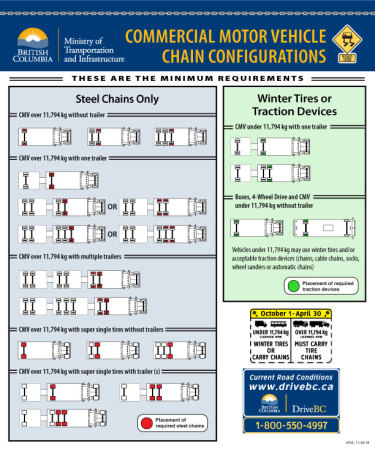Stricter chain up regulations implemented in B.C.
VICTORIA, B.C. – The B.C. government has placed stricter regulations on commercial drivers when chaining up, and includes all vehicles over 5,000 kg.
The move follows two other highway safety enhancements – reduced speed limits on 15 highway sections and restricting commercial trucks from the left hand lane on Snowshed Hill on the Coquihalla – announced recently, and is intended to improve heavy-duty vehicle performance during winter conditions.
“Last winter, 33 of 35 extended closures on the Coquihalla involved commercial vehicles, and in most cases this was due to truck drivers either poorly installing chains or not using them at all,” said Claire Trevena, minister of Transportation and Infrastructure. “While most drivers do chain up during winter weather, these new regulations, and the stricter fines that will follow will improve safety and hopefully reduce the number of closures.”
Prior to the change in regulation, only vehicles over 27,000 kg were required to carry and use traction control devices, with only one wheel needing to be chained up when mandated.
The new rule states: Vehicles less than 11,794 kilograms – like buses or five-ton trucks – must use chains on a minimum of two tires and can use steel chains, cable chains, automatic chains, socks or wheel sanders, if not equipped with winter tires; and, vehicles 11,794 kilograms or more must use steel chains, and the number of tires needing chains ranges from a minimum of two tires for vehicles without a trailer, to six tires on some larger and more-demanding configurations.
The B.C. Trucking Association (BCTA) had voiced its desire for stricter chain up regulations to Truck West when addressing the left lane ban on Snowshed Hill.
“While the intent to maintain a clear path in the left lane is laudable, this pilot does not address the primary cause of highway closures during severely inclement weather, which is the failure of some drivers to chain up,” BCTA president and CEO Dave Earle said at the time. “Unless this pilot is accompanied by significant regulatory change and increased enforcement, we are concerned that all the pilot may do is ensure it is only commercial vehicles trapped behind those few drivers who refuse to comply with the law.”
B.C.’s Ministry of Transportation and Infrastructure said it recognizes the short notice of this announcement, and will act accordingly when it comes to enforcement.
Commercial Vehicle Enforcement officers will provide education and information to drivers over the next few months prior to stricter fines being issued.
“The BCTA supports the government’s enhancements to commercial chain-up requirements, including the stiffer fines for those not compliant,” said Earle. “Safety of our drivers and all road users is our first priority.”
The amount of the fine is yet to be determined; previously, drivers faced a base level fine of $121 for not carrying or installing chain when required.
The ministry conducted a survey with industry and stakeholder in June 2018, which found that 70% of commercial drivers approved of enhanced chain up regulations. Over 90% said they were compliant with current laws, and 80% had the tools and training in place to implement the proposed regulations.

Have your say
This is a moderated forum. Comments will no longer be published unless they are accompanied by a first and last name and a verifiable email address. (Today's Trucking will not publish or share the email address.) Profane language and content deemed to be libelous, racist, or threatening in nature will not be published under any circumstances.
-
It’s too bad that most so called professional drivers use the new led lights as a means to blind oncoming traffic.. these new led lights should be set as low as possible from the factory. The new commercial drivers are too rapped up in their ego .
Sadly todays drivers don’t know how to “chain up” or “adjust brakes” ? The “Professional” driver of yesterday would consider that a major portion expected of Professionals! “DRIVER TRAINING IN NEED OF A “MAJOR” UPGRADE, before more carnage on our highways in BC. and across Canada. WHY is our Government so slow in implementing new training values ? Possibly the trucking companys lobbyists are stronger than our federal Government lackies !
The driver training they are talking about just means more crap forms as well as more so called rules and regs that will make for fewer people entering the workforce. You don’t really need to adjust brakes anymore btw and unless you have a ticket for it, try doing it at a scale house.
Most of the so caLLed carnage on BC highways is due to stupid four wheelers thinking they know how to drive. I was driving slowly in miserable conditions on the coq ( 5 )before Merrit watching stupid people pass me and cutting me off as well. A few miles later there they were(most but not all) sitting sideways or in the ditch. Wanting me to stop to help them, i gave them the italian salute and kept going.
To be honest it doesn’t bother me. All it means is that rates will keep climbing as companies try to fill seats. Fewer drivers means more money for me.
The use of LED headlights on all vehicles which are not correctly adjusted is a hazard for all other drivers as they blind oncoming traffic, even on low beam. I have a customer who uses LED headlights in his semi and when he put them in he carried a adjusting tool to adjust his headlights. If someone flashed him believing he was on high beam he adjusted the light down one turn on adjuster and kept doing this until he was no longer flashed. He said this did not effect the lights ability to give him more than enough light, in fact he said he didn’t notice any change. I believe he adjusted them down about 6 times.